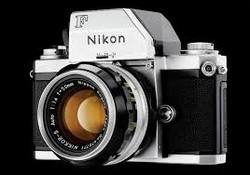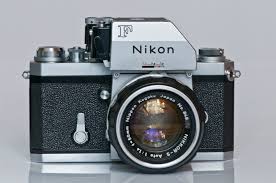 Nikon F w/ 50mm f/1.4 Auto Nikkor Nikon F w/ 50mm f/1.4 Auto Nikkor Updated July 25, 2019 Nikon has been in the SLR business since 1959. Which means there are plenty of choices as far as selecting a vintage camera body goes. Nikon initially marketed mostly to professionals. But in 1962 they entered the amateur market as well, and by 1979 they had three descending tiers: professional, enthusiast, and consumer which they maintain even today. Let's kick it off with the granddaddy of them all...the SLR that put Nikon on the map. In the Beginning...there was the F...and it was good. There was no mistaking whom Nikon was aiming at with the F. Their target was professional photojournalists who had adopted Nikon's rangefinder lenses and cameras with increasing frequency during the 1950's. The problem with rangefinders was that they could not make use of focal lengths longer than 135 mm unless an optional reflex box was added. The SLR (Single Lens Reflex) had no such limitations because the reflex box was integrated into the body itself. Nikon basically took their top end professional rangefinder, the SP, with its removable back and grafted a mirror/reflex box and interchangeable prism onto it along with a brand-new bayonet lens mount and there stood the mighty F. Control layout was identical aside from the new depth-of-field (DOF) preview & lens release buttons along with mirror lock up (MLU) dial on the front beside the lens mount. Over a span of 14 1/2 years around 860,000 were produced so you can still find one with little trouble. Quick specifications:
There were eight basic variations of the F, based on the finder options. The first and most desirable, in our opinion, is the plain F with the standard eye-level non-metered finder. We'll explain why below. The next four options are all finders with integrated meters called Photomic by Nikon. As improvements were made over time new models were introduced, so you went from a plain Photomic produced from 1962-66, the Photomic T from 1965-66, Photomic Tn from 1967-68, and finally, the Photomic FTn from 1968-74. Another article will cover the differences between these models and the three other non-metered specialty finders: the waist-level, action, and 6x magnifying finders.  Nikon F w/ Eye Level Finder Nikon F w/ Eye Level Finder So why is the plain eye-level F our pick of the litter? For three reasons: 1) There are no (read ZERO) electronics involved. The Photomics all used the now-banned and obsolescent 1.3 volt mercury batteries. Which is not a game-breaker in itself, as there are adapters available that allow you to use modern silver-oxide batteries. However, many of these 40 to 50+ year old finders are very sketchy when it comes to the reliability of their circuits. They can SOMETIMES be repaired...for a PRICE. 2) The second reason is more esoteric. Just having a plain black border around a 100% viewfinder with no distracting match needles, LED's, or LCD's can do wonders for composition. So what about metering?!? If you really want the vintage vibe, grab a handheld meter...or, if you're really feeling adventurous, have a go with Sunny 16 :-). The third reason is purely gratuitous, the plain eye-level F just looks cool. Thus, if you have one you'll look cool too ;-). One quick note, the eye-level prisms produced from 1959 - 68 do not accept screw-in diopters or the right-angle finder. From sometime in 1968 through to 1974 they do. They are easily differentiated by eyepiece shape: rectangular for older viewfinder and round for the latter. Be warned, however, that the eye-level prisms can suffer from de-silvering due to the deterioration of the foam used to seal them. If you are seriously considering an eye-level F, be sure to check for de-silvering and budget for having the old foam removed and replaced, whether you plan to DIY or get someone else to do it.  Nikon F Photomic FTn Nikon F Photomic FTn If you are bound and determined to have a Photomic, go for the FTn. It has both a greater film sensitivity range and a larger aperture coupling range, and it displays shutter speeds in the finder. You can sometimes find listings with both types of finders. It is generally cheaper to get a camera with the plain eye-level finder than to try and buy the finder itself separately. Another pricing factor is chrome versus black bodies. Black eye-level F's are usually more expensive (like, twice as much at least) because of greater rarity and black was the "pro" tone. So, how much can you generally expect to pay for a good user? For chrome bodies $250 - 300 USD. And double that for black. What are some other things to watch out for? There aren't many. F's have been likened to hockey pucks, anvils, and hammers when it comes to reliability, though we can't recommend substituting one for such. Pros and advance amateurs were the primary market for the F, so many were ridden hard and put away wet. The first thing to check is the condition of the shutter. The F has shutter curtains made from titanium foil 0.02 mm thick. They are very durable, but make sure they have no ripples, wrinkles or perforations. Also check for vertical cracks or tears at the edge of the curtains. While you examine them, check the condition of the film guide rails and edges of the pressure plate. They should be smooth and have no corrosion. Next, cycle through all of the shutter speeds activating the shutter each time. Pay particular attention to the 1/30 sec. and slower speeds and the 1/500 and 1/1000 sec. speeds. They are often the first to go out of spec and the camera will require a CLA (Clean, Lube, Adjust) if they are inaccurate. It would be wise to budget for a CLA, especially if you are not able to physically test the camera, when, for instance, you are buying from an auction or other online site. The F is fully mechanical, so all functions are carried out by means of springs, gears, and levers which from time to time will need a CLA to function properly. Good CLAs generally run $150 USD and up, nowadays. De-silvering of the prism, mentioned earlier, is easy to detect as you look through the viewfinder. It shows up as dark grey or black patches that interfere with viewing. It does not affect the image formed on the film, but does impact your ability to compose. Other than that, just making sure that all of the controls operate smoothly and positively should cover all the bases.
The Nikon F was a landmark 35mm SLR and the gateway to the vast F-mount Nikkor lens system. You could do much worse when it comes to selecting a vintage camera. Next time......Son of The F References: "Debut of Nikon F" @ Nikon Camera Chronicle Nikon F User Manual @ www.butkus.org Nikon F Finders @ www.mir.com.my Picture credits: www.wikipedia.org
2 Comments
Gary T
9/1/2020 11:33:46 pm
My father was a press photog in the 60s and 70s in Detroit. The Nikon Fs were the best, lenses, bodies, beat to hell and working great. He had a coworker get approached and hassled, about to be robbed. The guy swung his FTN with 200mm attached and knocked the robber cold!! Camera still worked fine, 200mm Nikkor had to be removed by a repairman but was fine too!
Reply
C.J. Odenbach
9/3/2020 09:18:20 am
Great story Gary. Thanks for sharing it :-).
Reply
Your comment will be posted after it is approved.
Leave a Reply. |
C.J. OdenbachSuffers from a quarter-century and counting film and manual focus SLR addiction. Has recently expanded into 1980's AF point and shoots, and (gack!) '90s SLRs. He even mixes in some digital. Definitely a sick man. Categories
All
Archives
June 2024
|
 RSS Feed
RSS Feed